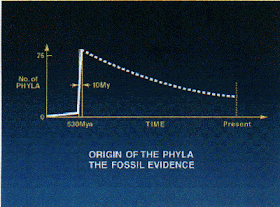Duck and cover! It’s the Cambrian Explosion!
Here’s a brief over view of evolution: Life started 3.5+ billion years ago. Then nearly nothing happens during the ‘boring billion’, as it’s affectionately known (with a lot of neat exceptions, like the Ediacaran fossils etc.). Then 580+- million years ago there was an ‘explosion’ of phylum constituting most of the 36 animal phyla now in existence. Some paleontologist estimate that as many as a 100 phylum were created over the period of only tens of millions of years. What gives? Why the billion years of nothing and then an explosion of diversity? Why haven’t we had a continuation or acceleration of this diversification? How come we’ve only added a hand full more phyla? Why hasn’t the pace continued? This blog will dabble in some of the exciting developments that have emerged in this exciting inquiry.


- Hox Genes: Evolution only works by mutations. ONLY. That means it can take a stupefyingly long time for big changes since big mutations are rare and the amount of big changes that are positive is vanishingly small. So, when a break through mutation happens, like in the hox genes (those genes that regulate embryonic development of body shape) that can give a whole new range of possibilities for evolution to play with. That is most likely what happened during the Cambrian Explosion - major developmental genes were developed and the landscape was drastically changed.

- Snowball Earth: If you don’t know about this, you are positively missing out. Several times in the Earth’s history our planet has looked like the ice cube Europa. Support for this includes evidence of glacier deposits at the then equator (based on paleomagnetism, marine sedimentation), and other chemical markers (like pH indicators, oxygen markers in iron deposits, iridium meteorite deposits, carbon isotope ratios, carbonite deposits, etc.) The last major Snowball Earth period was right before the so called Cambrian Explosion. This thaw out might have been the crack in the dam that had been building for some time.
 |
| Europa, one of the moons of Jupiter. |
 |
| Artist's rendition of what Earth may have look like as a snowball. |
- Oxygen Levels: This chemical is a major limiting factor for life. One might argue that we are oxygen powered animals since it serves such a vital function in making our energy. There’s more to it than just energy, though. What’s the most common protein in our body accounting for some 25-35%? Collagen. What’s collagen need a whole lot of to be made? Oxygen! What’s it do? It sticks cells together to make multicellular life and larger structures possible! So, during the Snowball Earth a massive amount of rock was pulverized and dropped into the ocean essentially as fertilizer to cyanobacteria that went nuts growing after the ice sheets melted away thereby producing a prodigious spike in oxygen levels.
 |
| That first bump up is the Cambrian Explosion. |
- Predation: Things had been eating each other for a long time, but not really at a multicellular level. During the Cambrian Explosion an arms race took place to hunt and escape that resulted in some amazing adaptations.
- Eyes: predation went from passive filter feeding to active hunting.
- Hard and Bony Parts: Being able to chew and have armor changed everything.
- Mouth: Just think sponge and jellyfish if you want kind of want to know what life was like before the C.E. Jaws changed everything.
 |
| Gotta love the names of Cambrian stuff. This is anomalocaris (from anomaly). |
So, why so little phylum generation since then?...Let me know if you have other thoughts, but I'd imagine that much of it would have to do with so many of the environmental niches being filled already...But, I'm open to other ideas!
Pix from here, here, here, here, here, here, here, here, here, here, here, here, here, here, and here.













Look up MAPCIS Impact Crater on Facebook. Massive Australian Precambrian/Cambrian Impact Structure.
ReplyDeleteCheers
Dan